To learn about the four basic DISC behavior types, we start with the DISC circle using the diagram shown below. For a more thorough description of how the DISC circle is developed, read this summary of the DISC model.
Each quadrant of the DISC circle has descriptive words attached to it that attempt to capture the typical behavior exhibited by people who have the combination of motor and compass drives that corresponds to that quadrant. The descriptive words show behavioral traits (or tendencies) that describe each quadrant of the circle.
To make conversation about the model easier to manage, we often call each quadrant a behavioral type or style. As you work with the DISC model, remember that it is not technically accurate to use the phrase personality type with this model. The DISC model is a behavioral style model. We recognize that the phrase personality is often used in normal, everyday conversation when talking about the model. In fact, we acknowledge the colloquial use of the word personality with regard to this model in the name and url of this site. In practice, we prefer to use the phrase behavioral style because it more accurately fits the model and its theoretical basis.
The main characteristic trait for each behavioral type (quadrant of the DISC circle) is used as the representative word for that type:
- Dominant,
- Inspiring,
- Supportive, and
- Cautious.
People who have both Outgoing and Task-oriented traits often exhibit DOMINANT and DIRECT behaviors. They usually focus on results, problem-solving, and the bottom-line.
People who have both Outgoing and People-oriented traits often exhibit INSPIRING and INTERACTIVE behaviors. They usually focus on interacting with people, having fun, and/or creating excitement.
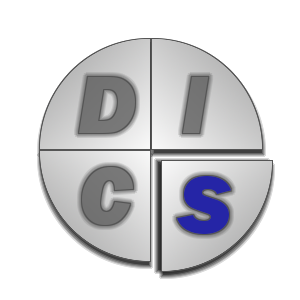 People who have both Reserved and People-oriented traits often exhibit SUPPORTIVE and STEADY behaviors. They usually focus preserving relationships and on creating or maintaining peace and harmony.
People who have both Reserved and People-oriented traits often exhibit SUPPORTIVE and STEADY behaviors. They usually focus preserving relationships and on creating or maintaining peace and harmony.
People who have both Reserved and Task-oriented traits often exhibit CAUTIOUS and CAREFUL behaviors. They usually focus on facts, rules, and correctness.
Some shortcuts you can use in discussing the different behavioral types:
- the DOMINANT type is also known as High D
- the INSPIRING type is also known as High I
- the SUPPORTIVE type is also known as High S
- the CAUTIOUS type is also known as High C
The DISC model can help you understand yourself and others by describing four main, or primary, behavioral styles. However, each individual person can, and likely will, display some of all four behavioral styles depending on the situation. This blend of styles within each person is called a style blend. Each person’s style blend will have more of some traits and less of others.

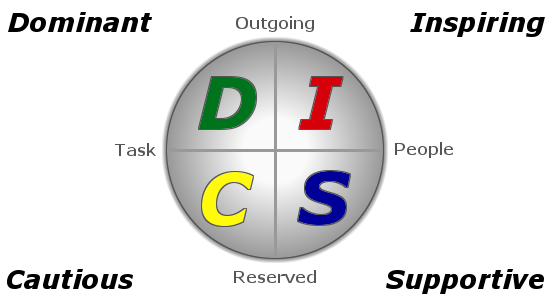
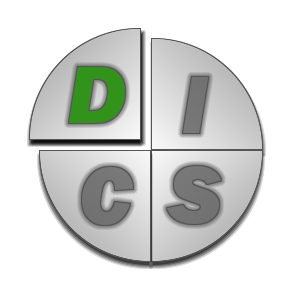

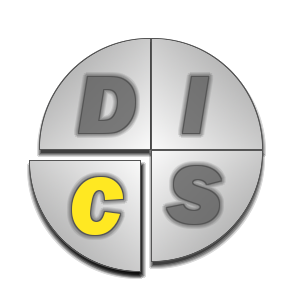
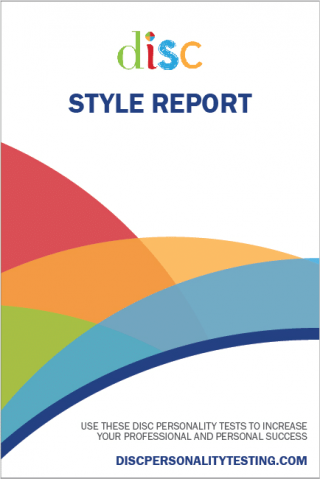
I learnt it wih other colors, like this:
Red as Dominant
Yellow as Inspiring
Green as Supportive
Blue as Cautious.
Do u have any idea for this color-change? (As for me red is describes a Dominant better coz red is an impulsive color whilst green is a peaceful one and more fitting for a Supporter.) Pls, explain it to me (who seems to be a Blue Cautious, who wants to get more – proper – information! ^^
Thank you.
Hi Jude,
Thanks for asking.
It’s not a change. It’s just a difference between how different people teach the model. There are several publishers of DISC assessments and training resources. Each publisher uses their own way of describing and teaching the model. What you described is just a different publisher from us.
Hi there,
I took this test at a work shop and scored the same equal score for all of the mentioned personalities
D – 30 points, I – 30 point, S -30 point, C – 30 points
I’m curious about this result as it doesn’t really help me identify the areas, that I should actually be focusing on improving.
This may sound like a rather silly question. But I was just wondering if you’ll be able to share more about results like this?
Hi Bel,
The numbers you reported come from an assessment scale different from ours. I’d suggest that you contact the providers of your assessment for an answer to your question.